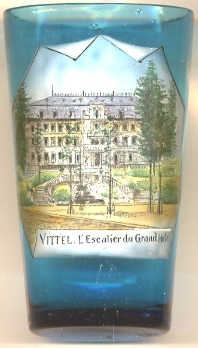

|
| FRANCE | FRANCE |
| région: Grand Est | |
| département: 88, Vosges |
 Vittel is situated at an elevation of 369 m in the département Vosges of the région Grand Est
of northern France. Vittel is part of the arrondissement Neufchâteau and is the chef-lieu of the canton Vittel. The municipality
has a population of about 5,500 (2010).
Vittel is situated at an elevation of 369 m in the département Vosges of the région Grand Est
of northern France. Vittel is part of the arrondissement Neufchâteau and is the chef-lieu of the canton Vittel. The municipality
has a population of about 5,500 (2010).
Situated on both sides of the river Petit Vair, the village historically belonged to two different owners: its part on the left bank, Grand-Ban, belonged to the abbey of Remiremont, while the right bank, Petit-Ban, belonged to the Duke of Lorraine. Thus, despite forming a compact settlement, the village had two separate jurisdictions and belonged to two separate parishes. This situation ended during the French Revolution when the single community of Vittel, now also the chef-lieu of the canton of the same name, was created. Although the mineral waters of Vittel had already been known during the Roman times, the modern development of the village as a spa only began in 1845. In 1854, after visiting the baths at nearby Contrexéville, lawyer Louis Bouloumié purchased the Fontaine de Gérémoy, site of the modern-day town of Vittel. Two years later, Bouloumié built a pavilion from which developed the grand, luxurious architecture which characterises the site. In the late 1960s the mineral springs were purchesed by the Nestlé company which today bottles several million bottles of "Vittel" per day for world-wide distribution.
During World War II the Nazis built a detention camp at Vittel. Here, the Jewish poet Itzhak Katzenelson wrote one of his best-known works in Yiddish language, "Dos lid funem oysgehargetn yidishn folk" ('The Song of the Murdered Jewish People'), which he completed on 17 January 1944. Katzenelson buried the manuscript in empty bottles under a tree; a copy was smuggled to Israel, sewn into the handle of a suitcase. Katzenelson was murdered by the Nazis in the concentration camp of Auschwitz, but both copies of his manuscript have survived.
The  Grand-Hôtel was built in 1912–1920 by the architect Georges Walwein in Belle Époque/Art déco style in the park of Vittel.
Today the hotel is part of the Club Méditerranée, opened in Vittel in 1969.
The hotel today offers 306 rooms on 6 floors.
Grand-Hôtel was built in 1912–1920 by the architect Georges Walwein in Belle Époque/Art déco style in the park of Vittel.
Today the hotel is part of the Club Méditerranée, opened in Vittel in 1969.
The hotel today offers 306 rooms on 6 floors.
[http://fr.wikipedia.org/wiki/Vittel, http://en.wikipedia.org/wiki/Vittel, https://de.wikipedia.org/wiki/Vittel;
https://de.wikipedia.org/wiki/Jizchak_Katzenelson, http://en.wikipedia.org/wiki/Itzhak_Katzenelson]
![[scale]](lineal.jpg)